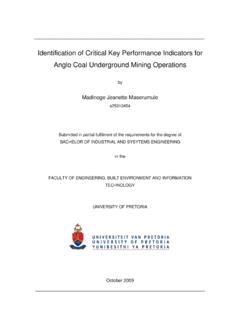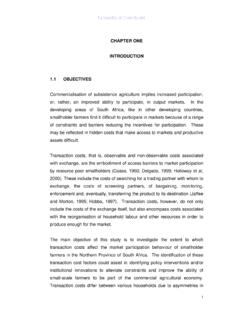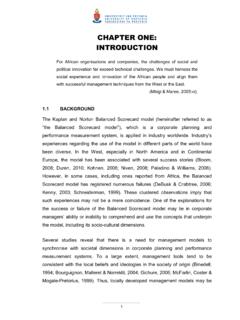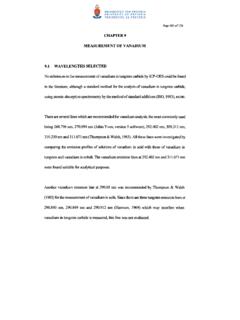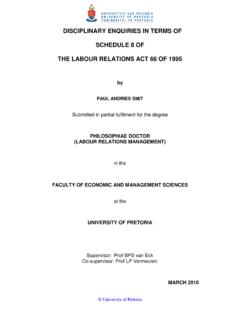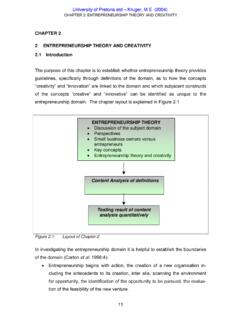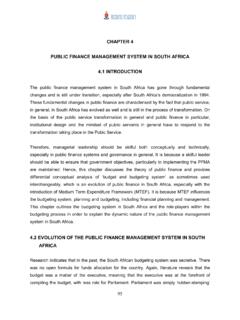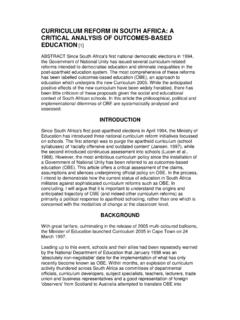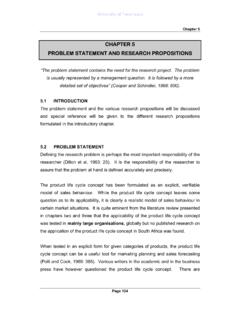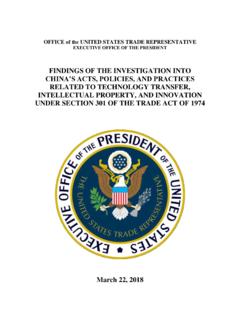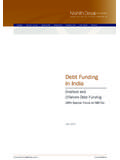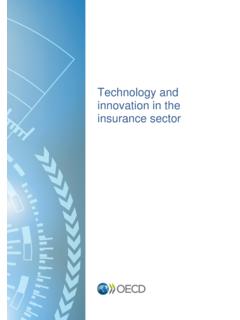Transcription of Chapter 2: Factors affecting SME success
1 Factors affecting SME success 28 Chapter 2: Factors affecting SME success Introduction This Chapter is a literature analysis aimed at reviewing local and international research to identify the set of skills that are important for SME success and growth. The Chapter starts with a brief discussion of all the Factors that have been identified as crucial for SME success , in order to give a background to the importance of skills in entrepreneurship. The Chapter defines those skills identified in literature as likely to influence SME survival and growth, as well as how the lack of skills can constrain SME development and ultimately lead to the failure of SMEs. Based on the exploratory study, the Chapter presents a model of SME-skills fit and venture success . This model is then translated into the propositions which this research study will prove or fail to prove.
2 Given the vast amount of literature on venture success /survival/failure (Gartner et al, 1999:216), this Chapter should not be regarded as a comprehensive review but merely as serving to highlight the importance of issues relating to the research topic. The focus of this literature review, then, is to outline the logic used for the selection of questions/variables for the research questionnaire. To determine the concepts to be included in the theory of the study, a comprehensive number of text books and articles were reviewed. The relevant literature is in leading academic journals and annual conference proceedings in such disciplines as marketing, entrepreneurship, management, social psychology, economics, organization behaviour and organization theory. This study limits itself to Factors specific to aspects of the functions of a business; it attempts to identify those Factors which strong empirical links to entrepreneurial success .
3 The Factors identified were divided into the following: Factors listed in published articles and books that list skill Factors from other studies. Factors listed in published articles that show strong evidence linking the skill factor to entrepreneurial success . Factors listed in published articles that link training and the said skill Factors . Factors that are cited by professionals in entrepreneurship models, theories and theorems. Factors affecting SME success 29 From this review the researcher drew up a range of possible skills that could be determinants of success , and of those whose lack could be a barrier to SME success . The Factors were evaluated for inclusion and a semi-structured questionnaire constructed and used as the research instrument.
4 The Chapter is structured under of four sections: Section 1 investigates the exogenous Factors that influence the entrepreneurial process. This is basically a brief discussion of the external Factors listed in table in Chapter 1. Section 2 investigates the endogenous Factors that influence the entrepreneurial process. This is basically a brief discussion of the internal Factors listed in table in Chapter 1. Section 3 reviews eight models on entrepreneurship performance and gives a combined model that links components of skills to business success /failure. This model provides guidelines for selecting the skills that the SMEs are requested to rank in the survey questionnaire. Section 4 is a conclusion that links the presented model to the propositions the research seeks to prove. The external/exogenous Factors Simpson et al (2004:484) defines the macro-environment as containing Factors external to the company that present situational variables which may facilitate or inhibit entrepreneurship at start-up and during the SME lifecycle.
5 This is supported by Dahlqvist et al, (2000:5) who expounds that these external Factors present opportunities, threats and information affecting all entrepreneurs within that environment, regardless of their background, education or business concept. Guzman & Santos (2001:217) lists external Factors to include socio-demographics, markets (local, international, emerging and established markets), cultural, economic, political, institutional, legal, productive, technological, infrastructure and other physical Factors of that particular environment. Mazzarol, Volery, Doss & Thein (1999:50) and Viviers et al (2001:4) point out that these macro environmental Factors are not controllable and the success of the SME often depends on management s ability to deal with them.
6 Peberdy and Rogerson (2000:21) argue that the success of a new venture depends on the state of specific Factors within the boundaries of specific nation-states with their own distinct economic, political and social Factors . Toye (2002:49) agrees and highlights that these Factors affecting SME success 30 Factors have implications for education and skill bases; levels of risk; access to markets; and access to resources including inputs, labour, subcontractors and expertise, networks, capital and finance. This influences the SME s chances of marginal survival or high performance (Dahlqvist et al, 2000:5). The study groups external Factors into two categories: macro economics and market-environment issues. Macro-economics variables include all economic, socio-cultural, and political-institutional Factors , whereas market environment includes all productive opportunities and market attractiveness Factors .
7 Economic Factors The success of a new venture depends on the state of the national economy at the time the business is launched (Baron, 2004b:233; Ligthelm & Cant, 2002:5; Viviers et al, 2001:4; Nieman, 2006:22, Gurol & Atsan, 2006:28). Examples of the economic Factors are discussed briefly below: Enterprise Density Enterprise density is defined as the number of firms in a given population at a given time and refers to the percentage of existing and possible entrepreneurs (Panco & Korn, 1999:6). In South Africa the enterprise density is low at 2%, meaning there is room for expanding active enterprises, and this low density acts as a disincentive to firms to exit (van Vuuren & Nieman, 1999:2; GEM, 2005a:17). Inflation Inflation has an effect on entrepreneurship (Viviers et al, 2001:4; Ligthelm & Cant, 2002:5).
8 South Africa s inflation figure of 11% in mid 2008 means that value of wealth decreases, consumers tighten their belts and thus there are fewer opportunities for entrepreneurs. Interest rates Low interest rates facilitate access to capital and thus resources required for entrepreneurship (Ligthelm & Cant, 2002:5). South Africa s high 15% prime interest rate (in mid 2008) limits both consumption rates and the amount of capital that can be raised (Viviers et al, 2001:4). Factors affecting SME success 31 Unemployment Unemployment impacts on the entrepreneurship process (Viviers et al, 2001:4). Where there is high unemployment a lot of people are pushed into entrepreneurship for survival (Wickham, 2001:63; Dollinger, 1999:43); at the same time because of this high unemployment and limited earnings, markets are naturally limited (Ligthelm & Cant, 2002:5).
9 South Africa s high unemployment rates mean that there is more people opting for self-employment yet spending power is limited. Exchange rates Exchange rates are a major factor in entrepreneurship (Viviers et al, 2001:4; Ligthelm & Cant, 2002:5). South Africa s weak rand means that there is more opportunities inm the export market but that there is less capital for investing in local SMEs. Taxation One of the key Factors inhibiting SME development is taxation (Robertson et al, 2003:311). If tax rates are high they reduce the profit incentive drastically (Ahwireng-Obeng & Piaray, 1999:78). In South Africa costs associated with meeting VAT (Clover & Darroch, 2005:242) and corporate tax (Viviers et al, 2001:4) are among the highest in the world. The complexity of the tax system further raises the cost of doing business, as many SME do not have the capacity to administer tax returns and thus need to consult experts for a fee in order to meet these legal requirements (Luiz, 2002:65).
10 Change The ability to deal with change is a key factor in the success of SMEs (Viviers et al, 2001:4), as change and its related uncertainty are where market opportunities lie (Kirzner 1973; Knight, 1964). Change includes rapidly changing technology (Ligthelm & Cant, 2002:37) and changing market forces (Shane & Venkatarman, 2000:220). South Africa re-entry into the global economy after decades of international trade sanctions opened the floodgates of change (Morris & Zahra, 2000:92). Sadly most SMEs in South Africa lack the capacity to deal with a changing business environment (Strydom & Tustin, 2003:4) and are thus doomed to eventual extinction (Panco & Korn, 1999:7). The business environment Positive features of the business environment of a country provide SMEs with opportunities, threats, information and access to role models (Hisrich & Peters, 2002:73; Guzman & Factors affecting SME success 32 Santos, 2001:217; Henning, 2003:2), which are Factors determining SMEs / entrepreneurial success (Pretorius et al, 2005a:55; Nasser et al, 2003:400).
